Mule Deer
(Odocoileus hemionus)
Species Profile
Did You Know?
Mule deer get their name because their large ears resemble those of a mule.
General Description
Identification
The mule deer is named for its large ears, that resemble those of a mule, which are about three-fourths the length of the head. It can also be identified by the color and shape of its tail and overall size - especially when compared to the other two subspecies, the Sitka black-tailed and Columbia black-tailed deer.
The coat of a mule deer is reddish-brown in the summer, and transitions to brownish-gray in winter. They have a distinctive white rump patch and a narrow white tail with a black tip.
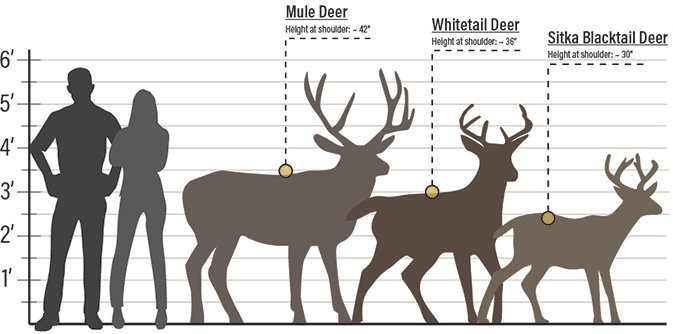
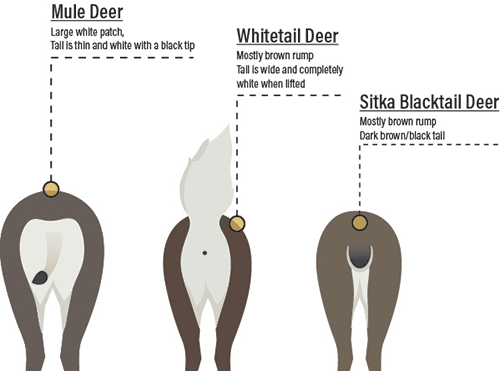
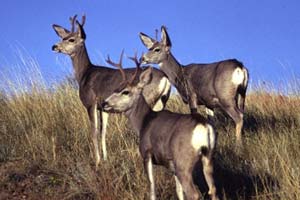
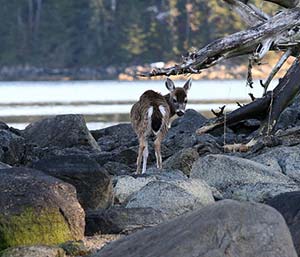
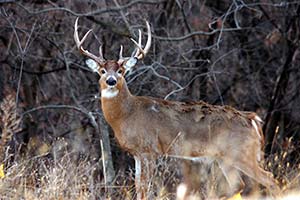
Mule deer vs. Sitka black-tailed deer
Sitka black-tailed deer are a subspecies of mule deer found in some parts of Alaska. Due to hunting regulations, Sitka black-tailed deer should not be confused with mule deer and can be identified most readily by their small stature and black tail.
Mule deer
Does: 110-165 lbs
Bucks: 150-250 lbs
Distinguishing characteristics: Bifurcated, or forked, antlers on bucks; each beam forks, antlers are larger when compared to Sitka black-tailed deer, narrow tail is white with a black tip, and large, mule-like ears. Not common in Alaska.
Sitka black-tailed deer
Does: 80 lbs
Bucks: 120-200 lbs
Distinguishing characteristics: Small in stature, tail is completely black or dark brown when in lowered position, bucks have bifurcated antlers; each beam forks and antlers are smaller when compared to mule deer, and the face is dark. Common in Southeast Alaska, Prince William Sound and on Kodiak Island.
White-tailed deer
White-tailed deer are an entirely different species but overlap in range with the mule deer in some places. They are uncommon in Alaska. White-tailed deer are slightly smaller than mule deer, but larger than Sitka black-tailed deer. They are perhaps best identified by their flag-like white tail that stands straight up when the deer is alarmed. Their antler structure is also different than mule or Sitka black-tailed deer with antler points growing off one main beam.
Life History
Growth and Reproduction
Beginning in late October, mule deer bucks enter the "rut" or mating season. Bucks closely matched in size and strength may engage in battles for the right to mate with does in estrus. They lock antlers and fight until one buck backs down and flees. These victorious bucks attract females to them and attempt to defend them against the attention of other (often younger) bucks. Sexual maturity happens around 18 months for does; the prime mating age for bucks is between three to six years of age. Does may mate with more than one buck and go back into estrus within a month if they do not become pregnant.
The gestation period is approximately 200 to 210 days, and the bulk of the fawning period happens in early summer. The female isolates herself and drops her fawn in a protected spot, where it remains for 7-10 days before it is strong enough to follow her. At birth, fawns are spotted and weigh approximately 5.5 pounds (2.5 kilograms). The young ones are weaned between 60 to 75 days, at which time they begin to lose their spots. Mule deer usually live 9 to 11 years in the wild.
Diet
Mule deer are primarily browsers, feeding on leaves and twigs of woody shrubs. They are also known to graze on herbaceous plants. Mule deer are selective feeders. Instead of eating large quantities of low-quality feed like grass, they select the most nutritious plants and parts of plants.
Range and Habitat
Mule deer are not native to Alaska, but are a native North American ungulate with a range that includes the Yukon Territory, Canada. Occasional sightings have been reported in the eastern Interior since at least the 1970s. All have likely immigrated from within the species' current range in Yukon, Canada. A mule deer was killed by a vehicle near Fairbanks in May, 2017; In 2013, three were reported north of Delta Junction; and a mule deer was photographed in July 2016 near the Fort Knox gold mine near Fairbanks. Canada's Yukon Territory has an established mule deer population, and therefore mule deer naturally migrate west through valleys, forests and tundra habitats. Mule deer have also been seen in Southeast Alaska, with sightings reported near Haines and Skagway as recently as spring of 2019.
Basic mule deer habitat requirements include an abundance of forage, vegetation and terrain that provides safety, shelter, and access to water. Mule deer generally summer at higher elevations and migrate to lower woodlands or shrublands in winter to find food, avoid predators and seek cover from harsh weather.
The Columbia black-tailed deer, smaller than mule deer but larger than the Sitka subspecies, ranges from Northern California through Western Oregon and Washington to southern British Columbia, the Sitka subspecies ranges north from British Columbia into Alaska.
Status, Trends, and Threats
Not much is known about the population status of mule deer in Alaska as they are an incidental species which is naturally expanding their range into Alaska.
However, because mule (and white-tailed) deer — along with other ungulates such as caribou and wood bison - can be asymptomatic carriers of disease and parasites that can sicken Alaska's native big game species, the Alaska Department of Fish and Game is actively requesting samples from harvested mule deer in the state. See how you can help to get involved.
Fast Facts
-
Name
Mule deer get their name because their large ears resemble those of a mule.

